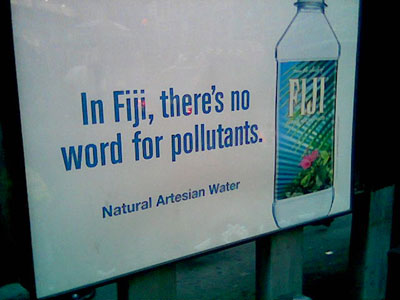May 05, 2006
Whorf in a bottle
Courtesy of Grant Barrett (who in turn credits fellow lexicographer Erin McKean), here's a naively Whorfian advertisement spotted along Fifth Avenue in New York.
(For more variations on the "No Word for X" trope, see the list of posts linked here.)
[Update: As is so often the case with this trope, the intent is to exoticize a faraway "primitive" land, in this case linking the "Fiji" brand of bottled water with an Edenically pristine image of an island nation unfamiliar both linguistically and culturally with "pollutants." Sadly, as Mark Liberman points out, the reality is quite different, as a Google search on {Fiji pollutant} readily demonstrates. A sampling:
Posted by Benjamin Zimmer at May 5, 2006 12:45 PMThe population of Suva, capital of Fiji, is about 187,000. Three kilometres west of Suva, adjacent to the sea, is a six-hectare landfill site called "Lami Dump". The site was mangrove until 40 years ago. Today, about 60,000 tones of waste from factories, shops and households are brought in annually (figures from Fiji 1 website). The waste matter has been piled up several meters high. The land lease contract with the owner has expired, and it will soon be impossible to add further waste to the site. There are no pollution prevention measures in place. An offensive odour spreads several hundred metres to surrounding homes and businesses. The site hosts flies, cockroaches and rats, which spread endemic diseases like bacillary dysentery. In addition, high concentrations of toxic substances like arsenic, cadmium, mercury and lead, and persistent organic pollutants (POPs) such as organic acids, are leaching into the soil and seawater around the site, resulting in degradation of marine water quality, destruction of habitat, loss of property values and reduced fish marketability, amongst others (UNEP Report number 174, 2000). (link)
The Kinoya wastewater treatment plant in Suva, Fiji, caters for a population of 85,000. Incoming BOD and suspended solids (SS) are approximately 450mg/L and 290mg/L with final effluent at 20-45mg/L and 30-60mg/L respectively. (link)
Fiji is fortunate in having considerable resources, timber, land, marine products, and some minerals. But in recent years their exploitation has not been sustainable, in fact they have been 'mined' for quick economic return without effective environmental and social considerations and regard for the future. This is common in marine products, forests and agriculture. The poor logging and forest management is 'mining' the timber and water catchment's resources, the ginger industry is 'mining' the soil resources, so as the sugar industry on the marginal coastal lands. Over the years, many development assistance agencies have encouraged this shortsighted approach through their focus on narrow economic targets. ...
Fiji's population growth rate is moderate, but the urban and peri-urban growth rate is high, and is clearly outstripping infra-structural planning and development. Thus it is primarily responsible for the important social issues of environmental concern, such as housing, water and sanitation. Direct regulating control of water or air pollution and monitoring are absent. ...
[Sugar] is the second largest industry in Fiji, generating approximately $300 million in revenue, through the production of 470,000 tonnes of sugar. Approximately 700km2 of land is used in growing sugar cane in Fiji. The main environmental hazards of cane fields are the 'inputs' use, fertilizer weedicides and pesticides. There are no regulations to specifically control how they are used on farms and other work places. ...
Saw milling is becoming big in Fiji, especially when there is a big demand for pine chips in Japan and pine timber for local and overseas market. There are about 20 sawmills with timber treatment facilities. 70% of the logs are chipped for sale to Japan and the remaining 30% converted to timber. In terms of solid waste, these sawmills produce about 14,000 tons of wood waste a year, which accumulates in rubbish tips that are continuously smoking from spontaneous fire. Some chemical wastes containing copper, chromium and arsenic are generated by treatment plants. ...
The results show a significant high number of contaminations ... It is of great concern that in all Divisions, some treated supplies were also contaminated. (link) ]
